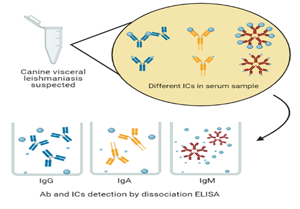Published online by Cambridge University Press: 05 July 2021

Immune complexes (ICs) are found in canine visceral leishmaniasis (CVL) and interfere with the serum detection of antibodies. Dissociation of these monovalent complexes by dissociative enzyme-linked immunosorbent assay (ELISA) removes false-negative results and allows some characterization of antibodies and antigens. We studied the serology of dogs with suspected CVL in an endemic area, testing two Leishmania (Leishmania) [L. (L.)] <full form>infantum antigens. We analysed the presence of immunoglobulin G (IgG), immunoglobulin A (IgA) and immunoglobulin M (IgM) antibodies specific to promastigote soluble extract (PSE) and low-molecular weight glycans (glycan–bovine serum albumin (BSA) complex – GBC) by conventional and dissociative ELISA. Our results showed a significant fraction of IgA ICs (46.5% for PSE and 47.6% for GBC), followed by IgG ICs (10% for PSE and 23.5% for GBC). IgM ICs were more frequent for PSE (22.7%). Hypergammaglobulinaemia in CVL would be related to the presence of IgA and IgG ICs, resulting in deficient elimination of these antibodies. Our data confirmed the presence of ICs that can generate false-negative results in conventional serology. The production of IgA antibodies and the high frequency of blockade by glycan antigens suggest the active participation of this immunoglobulin and its ICs in the immunopathology of CVL, indicating a new path for further research.